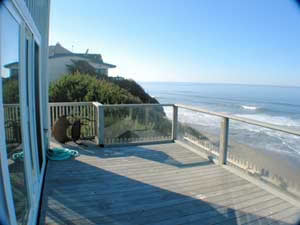 |
Busy Tourist Weekend Brought Danger to Oregon Coast |
|---|
Covering 180 miles of Oregon coast travel: Astoria, Seaside, Cannon Beach, Manzanita, Nehalem, Wheeler, Rockaway, Garibaldi, Tillamook, Oceanside, Pacific City, Lincoln City, Depoe Bay, Newport, Waldport, Yachats & Florence.
03/09/08
Secrets of the Season |
Busy Tourist Weekend Brought Danger, Deaths to Oregon Coast
 |
| South of Cannon Beach on Saturday: lovely, calm waves bely the danger |
(Gleneden Beach, Oregon) – Sunny conditions and somewhat deceptively calm seas brought a flood of visitors to the Oregon coast over the weekend, but with that came a run of rescues and two fatalities. One rescue was in Cannon Beach and two were near Depoe Bay.
It all caused beach experts to issue more warnings about playing on the beaches or in the ocean.
An Oakridge, Oregon boy died at a Lincoln City hospital on Saturday after he drowned in the waters of Gleneden Beach, between Lincoln City and Depoe Bay. Another 16-year-old boy who tried to rescue the boy was lost in the ocean and presumed dead.
The U.S. Coast Guard and crews from the Depoe Bay Fire Department responded to an emergency call of two boys in trouble at Gleneden Beach. First, an 11-year-old boy was reported drowning in the ocean. Five people attempted to save him and were not successful.
 |
| Gleneden Beach |
Eventually, a Depoe Bay fireman was able to pull the boy out of the water. He was in critical condition for a short time, but died later at Samaritan North Lincoln Hospital.
One of the would-be rescuers was a 16-year-old who disappeared in the sea. Crews suspended the search for his body just before 5 p.m. on Saturday.
The two boys did not know each other. Officials from Oregon State Police say family members of the 16-year-old reported him missing to authorities on the beach, believing he went into the surf to look for the first boy.
The 11-year-old is identified River Jenison of Westfir, which is located near Oakridge. The missing 16-year-old has been identified as Ross Barfuss.
As this rescue was taking place, another emergency call came in from Otter Rock regarding a surfer in trouble there – about ten miles south of Depoe Bay.
When crews arrived, they found family members of the surfer were able to rescue him. He was taken to the hospital in Newport and treated for hypothermia.
 |
| Gleneden Beach |
In the Cannon Beach area, also on Saturday, a pair of kayakers required rescuing after their practice runs at kayaking went awry.
A1 Beach Rentals, Lincoln City. Perfect for large family vacations all the way down to a getaway lodging for two - with over 25 vacation rental homes to choose from. A breathtaking collection of craftsman or traditional beachfront homes, or oceanview houses – from one to seven bedrooms. In various areas of Lincoln City and overlooking the beach, with some in Depoe Bay. All kinds of amenities are available, like hot tubs, decks, BBQ, rock fireplaces, beamed ceilings and more. Some are new, some are historic charmers. Lincoln City, Oregon. 1-(503)-232-5984. www.a1beachrentals.com. |
Dave Pastor, a video reporter from Cannon Beach, filmed the pair being rescued by a Coast Guard helicopter at Arcadia Beach, a tourist hotspot a few miles south of town.
Portlanders David Dean and Laura Whittith were beginners who were trying to get more experience when Whittith capsized.
“They were trying to do their practicing, when she got caught in a rip current and dragged out to sea,” Pastor said. “He swam out to try and save her, and got stuck on the rocks.”
 |
| Otter Rock |
Onlookers called 911 and the Coast Guard showed up to pull them out. The kayaks were lost.
Pastor said the two graciously talked to him as he filmed the story for local TV stations. They then drove away in their own car – not taken to the hospital as was reported by some officials.
Conditions on the ocean may have looked somewhat calm and blue under the sunny skies of the weekend, but they weren’t. Sneaker waves were rampant throughout the day, with the ocean receding then suddenly bursting in with a difference of 300 feet between the lowest point and the highest tide line in some places – all within the space of a few minutes.
|
The Ocean Lodge. There will not be another property built like this in Cannon Beach in our lifetimes. Rare, premiere ocean front location; handsome, dramatic architecture and tasteful, fun (nostalgic) beach interiors. Overlooks Haystack Rock. 100 percent smoke free. Imaginative special occasion packages. Massive wood burning lobby fireplace. Library w/ fireplace, stocked with impressive book collection. Pet and family friendly. Lavish continental buffet breakfast. In-room fireplaces, mini-kitchens. Jacuzzi tubs in select rooms. DVD players, complimentary movies. Morning paper. Warm cookies. 888-777-4047. 503-436-2241. 2864 Pacific Street. Cannon Beach, Oregon. www.theoceanlodge.com |
Guy DiTorrice, a beach expert and former fire department captain who has had made numerous beach rescues over the last decade or so, said part of the problem was the sheer numbers of people on the coast.
 |
| Arcadia Beach access, near Cannon Beach |
“When I was playing on the beach early in the morning, the parking lot at that beach was empty,” DiTorrice said. “By one o’clock, the parking lot was full. It was sunny and nice. I think a lot of people were trying to avoid spring break too.”
Still, beach experts on the Oregon coast wouldn’t call conditions deceptively calm. They say it’s always a place to be extremely cautious.
“We didn’t have particularly big waves this weekend,” said Keith Chandler, manager of Seaside Aquarium. “Use common sense. The ocean feels deceptively nice right now, especially after it hasn’t been nice in a while. But the water is cold, about 45 degrees. It’s 20 degrees colder than it is in summer. You can lose heat fast and get hypothermia.”
Chandler said inexperience is often a key to such events as the run of rescues this weekend.
 |
| Rocky structures at Arcadia could've spelled problems for this weekend's kayakers |
“I wouldn’t call things deceptively calm at all this weekend,” he said. “You’ve got to remember, we’re in a state where it takes only two inches of water to lift a giant log. I think people look at that ocean and think they’re a little safer than they are. They need to remember the forces of nature are more powerful than we are.
“The tides and currents may look normal on the surface, but they’re not. The direction that the waves are going is different from the currents underneath.”
DiTorrice said many of these rescue situations happen around rocky headland areas, which makes for more deceptively stable conditions on the surface as currents will edge people into places they didn’t expect.
 |
| Gleneden Beach |
“In these cases, there’s always entry made on a sandy beach, but there’s a rocky area nearby,” he said. “No one intends to go the directions of the rocks. But the currents don’t go back and forth.”
Currents in general run northerly during the spring, DiTorrice said. But rip currents are an especially dangerous element lurking beneath the waves, which can’t be seen. If you get caught in a rip current, stay with it: it won’t last long. You can’t swim out of these extremely strong currents. But if you stay with the rip current, it will dissipate soon, and you’ll be able to swim out.
Chandler said the best offense for situations like this is not get into them in the first place.
To avoid getting in such dangerous predicaments, DiTorrice suggested sticking to the info provided by locals, especially for surfers. Surf shops gladly give out such recommendations for free.
 |
| Tides and currents at Otter Rock can be especially nasty |
But what about those five rescuers in Gleneden Beach Saturday – and what if you’re in such a situation where you witness a drowning? Do you swim out to help and risk your own life, sometimes to a greater degree?
 DiTorrice
and Chandler are steadfast against it, lest you wind up like the boy who
was lost trying to save the pre-teen in Gleneden Beach.
DiTorrice
and Chandler are steadfast against it, lest you wind up like the boy who
was lost trying to save the pre-teen in Gleneden Beach.
“A couple of years ago, I had to deal with a rescuer who didn’t come back in the Newport area,” DiTorrice said. “Stay on the scene and dial 9-1-1. Stay there so you can give the operator the visual location so the helicopters and rescuers know exactly what to do.
“I was on the scene in Newport for that drowning. The person who went in to save someone else died, not the first person who got in trouble. We rescued him. Now there’s a dead hero.”
Chandler admitted this would be a hard thing to stand by and watch.
“I don’t really know what I’d do,” he said. “I can’t say I wouldn’t go out and help, but I know I will say I shouldn’t.”
 |
|
Tradewinds Motel, Rockaway Beach. All rooms are immaculate and have TV’s, VCR’s and in-room phones w/ data ports. Oceanfronts have queen bed, a double hide-a-bed, kitchen, cozy firelog fireplace and private deck. Both types sleep up to four people. Others are appointed for a two-person romantic getaway, yet still perfect for those on a budget. Elaborate oceanfront Jacuzzi suite has two bedrooms, kitchen, double hide-a-bed, fireplace and private deck, sleeping as many as six. For family reunions or large gatherings such as weddings, some rooms can connect to create two-room and three-room suites. Some rooms pet friendly. 523 N. Pacific St., Rockaway Beach. (503) 355-2112 - 1-800-824-0938. www.tradewinds-motel.com |
 Inn
at Cannon Beach. Beautifully wooded natural setting at quiet south
end of Cannon Beach. Great during winter storms with a new book by
the fireplace – or when the sun is out for family fun and beach
strolling. Handsome beach cottage-style architecture. Lush flowering
gardens and naturalized courtyard pond. Warm, inviting guest rooms.
Continental buffet breakfast. Warm Cookies. Family and Pet Friendly.
Welcome gifts. Smoke-free. Complimentary Wireless Connectivity. Wine
and book signing events. 800-321-6304 or 503-436-9085. Hemlock At
Surfcrest, Cannon Beach, Oregon. www.atcannonbeach.com. Inn
at Cannon Beach. Beautifully wooded natural setting at quiet south
end of Cannon Beach. Great during winter storms with a new book by
the fireplace – or when the sun is out for family fun and beach
strolling. Handsome beach cottage-style architecture. Lush flowering
gardens and naturalized courtyard pond. Warm, inviting guest rooms.
Continental buffet breakfast. Warm Cookies. Family and Pet Friendly.
Welcome gifts. Smoke-free. Complimentary Wireless Connectivity. Wine
and book signing events. 800-321-6304 or 503-436-9085. Hemlock At
Surfcrest, Cannon Beach, Oregon. www.atcannonbeach.com. |
Weiss' Paradise Suites & Vacation Rentals - Seaside Unique Luxury Accommodations in Seaside. 1BR Suites,
1BR & 2BR Duplex Units and 3BR Houses, units for 2-8 people.
Rent entire property for 20-26. Close to beach, river and Broadway
St. |
|
Arch
Cape Property Services.
Dozens of homes in that dreamy,
rugged stretch between Cannon Beach and Manzanita known as Arch
Cape. Oceanfront and ocean view , or just a short walk from the
sea. |
Lincoln City Vacation Homes Something for everyone: smaller homes with a view to a large house that sleeps 15. All are either oceanfront or just a few steps away – all with a low bank access and fantastic views. Most are in the Nelscott area; one is close to the casino. You’ll find a variety of goodies: fireplaces, multiple bedrooms, dishwashers, Jacuzzis, washer/dryers, hot tubs, cable TV, VCR, barbecues; there’s a loft in one, and another sprawling home has two apartments. Pets allowed in some homes – ask first. Each comes with complete kitchens. Most have seventh night free. Prices range from winter $85 to summer $230 per night. www.getaway2thecoast.com. 541-994-8778. |
RELATED STORIES
Click here for video of Dec. storm aftermath
Oregon Coast Best of Awards for the Year And the winners are: best of Oregon coast restaurants, lodgings, science, odd events in nature and stunning moments for 2007
Watching Transformations of Oregon Coast Beaches Seasons change and so do beaches, revealing different sides and a variety of eye-popping sights
Staggeringly Cool Ideas for Oregon Coast Romance Be it the season of Valentine's or be it any time of the year, Oregon's coastline has essentially cornered the market for cuddle-inducing possibilities and gushy activities for the hand-holding set
Day or Night Mysteries and Merriment on Oregon Coast It's more than just nightlife that comes to life, but the beaches offer major opportunities
Oregon Coast Travel Site Goes Wireless Provides Lodging Reports - Oregon Coast Beach Connection now has mobile lodging and dining listings, along with weekly lodging availability reports



































